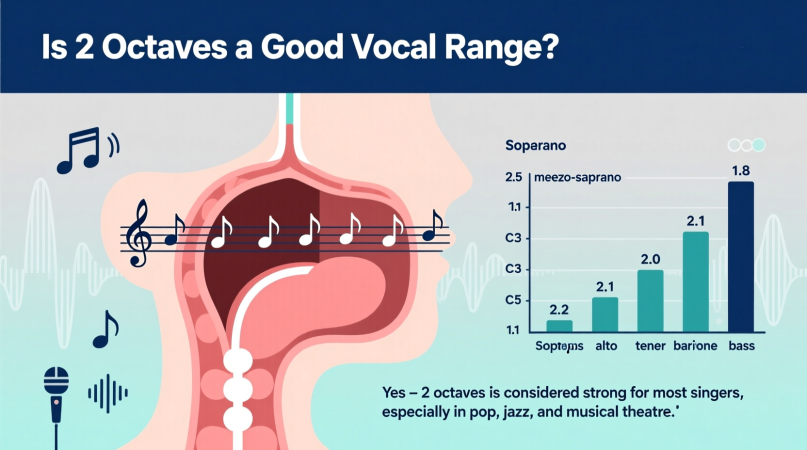
Many singers eventually ask themselves: “Is my range enough?” If you’ve measured your voice and found it spans around two octaves, you might wonder whether that’s average, limited, or even impressive.
The truth is, vocal range is only one part of what makes a singer powerful. Let’s break down what two octaves really mean, how it compares to other singers, and what you can do with it.
What Does “2 Octaves” Actually Mean?
An octave is the distance between one note and the next note of the same name, higher or lower in pitch. For example, the note C to the next higher C is an octave.
If your voice spans two octaves, that might mean you can comfortably sing from C3 (a low note for men) to C5 (a high note for men and a mid-note for women). Another example could be A3 to A5 for a female voice.
It’s also important to separate your usable range (where your tone is reliable and comfortable) from your absolute extremes (the highest or lowest squeaks or growls you can produce). Singing teachers usually emphasize your usable range.
Is 2 Octaves Normal or Exceptional?
The answer depends on context:
- Untrained singers: Most people without formal training fall somewhere around 1.5 to 2 octaves.
- Trained singers: With practice, many expand to 2.5 or 3 octaves.
- Professionals with extreme ranges: Some famous vocalists (Mariah Carey, Axl Rose, Freddie Mercury) span four or more octaves.
So, if you have a solid two octaves of control, you are right in the average to healthy range for everyday singers. For pop, rock, and even choir music, this can be more than enough.
👉 If you’re unsure how to measure, you can try a vocal range test that maps out your highest and lowest reliable notes.
Pros of Having a 2-Octave Range
1. It’s Manageable
With a two-octave range, you’re working within a span that many songs are written for. Most popular music doesn’t exceed this.
2. Better Consistency
Singers with “only” two octaves often have more control, better tone, and fewer cracks than those pushing for extremes they can’t fully handle.
3. Less Strain
Attempting to push into wider ranges without technique can damage the voice. With two octaves, you’re in a safe zone.
Limitations of a 2-Octave Range
1. Song Selection Can Be Limited
Certain songs require broader range—especially opera, gospel, or high-flying pop ballads. You may need to transpose (shift keys) to fit.
2. Harder to Stand Out
In genres that prize showmanship (like R&B or rock ballads), singers with larger ranges might capture more attention.
3. May Cap Your Growth
If you stop training, two octaves might feel limiting over time. With structured vocal work, though, you can expand gradually.
Comparing 2 Octaves with Other Ranges
Here’s a benchmark table for context:
| Range Span | Typical Classification | Examples |
|---|---|---|
| 1 – 1.5 octaves | Untrained / casual | Average choir member |
| 2 octaves | Average singer | Many pop vocalists |
| 2.5 – 3 octaves | Trained singers | Beyoncé (~3), Adele (~2.5) |
| 3 – 4 octaves | Exceptional | Freddie Mercury (~3+), Christina Aguilera (~4) |
| 4+ octaves | Rare / extreme | Mariah Carey (~5), Axl Rose (~5.5) |
This shows that two octaves put you in a healthy, workable zone—but expansion is possible.
Famous Singers with Modest Ranges
Not every legend had a massive vocal span. Some iconic artists stayed close to two octaves but made history with tone, style, and emotion rather than extreme high notes.
This proves that musicality > raw range in many cases.
Can You Improve Beyond 2 Octaves?
Absolutely. While genetics play a role, training can safely expand your range. Here are proven strategies:
Warm-Up Consistently
Start with gentle scales, humming, and lip trills before singing at full volume.
Use Sirens
Sliding smoothly from your lowest to highest note helps unlock transitions between registers.
Strengthen the Passaggio
This is the tricky “bridge” between chest and head voice. Exercises focusing here can unlock higher notes.
Practice Semi-Tones
Move upward or downward half a step at a time to carefully push limits.
Avoid Strain
If your throat hurts, stop. Growth comes from consistency, not forcing.
👉 Track your progress with tools like a Check Your Range with a Calculator to see when you break past two octaves.
Does Range Really Matter More Than Tone?
One of the biggest misconceptions in singing is that wider range automatically equals better singer. In reality:
- Tone, style, and emotion often matter more to audiences.
- Many chart-topping songs sit comfortably within a single octave.
- Having a controlled two octaves is usually more useful than an unstable four.
FAQs
Is 2 octaves a good vocal range?
Yes. It’s around average for most singers, and enough for many genres.
Can I expand from 2 to 3 octaves?
With consistent training and proper technique, many singers expand by at least a half-octave to a full octave.
Do professional singers only have 2 octaves?
Some do. Range doesn’t always define success; tone and artistry often matter more.
What’s the average vocal range?
Around 1.5 to 2 octaves for untrained voices; 2.5 to 3 for trained singers.
Does vocal range matter for pop music?
Not as much as people think. Many pop songs stay within 1–1.5 octaves.
